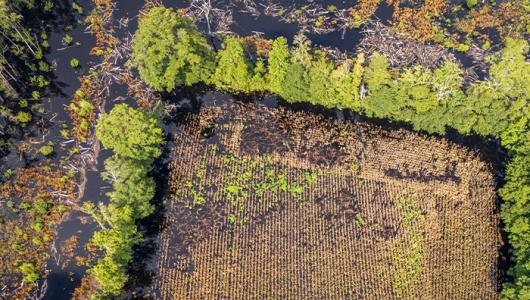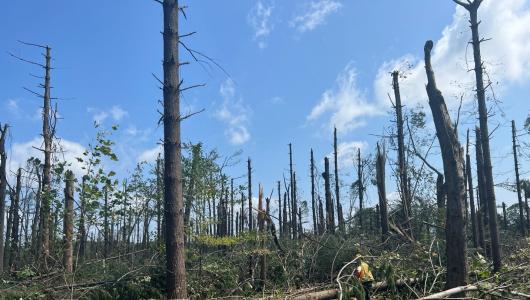Farmers and ranchers rely on crop insurance to protect themselves from disasters and unforeseen events, but not all crops are insurable through the USDA’s Risk Management Agency. The Farm Service Agency’s (FSA) Noninsured Crop Disaster Assistance Program (NAP) provides producers another option to obtain coverage against disaster for these crops.
NAP provides financial assistance to producers of non-insured crops impacted by natural disasters that result in lower yields, crop losses, or prevents crop planting.
“NAP covers crops that cannot be covered by traditional crop insurance options, so it fills a gap in risk management for many production agriculture operations,” said Rebecca Csutoras, an FSA farm program chief in Harrisburg, Pennsylvania.
What Crops Are Eligible For NAP?
Commercially produced crops and agricultural commodities for which crop insurance is not available are generally eligible for NAP. Eligible crops include those grown specifically for food, fiber, livestock consumption, biofuel or biobased products, or be commodities such as value loss crops like Christmas trees and ornamental nursery, honey, maple sap, and many others. Contact your FSA office to see which crops are eligible in your state and county.

“A lot of producers don’t know crops, like grain and forage, that are intended for livestock consumption are covered under NAP,” said Rebecca. “If you think about the drought conditions and wildfires impacting a large part of the United States and the impact of those conditions on native grasslands, pasture and forage crops, it is easy to see how the loss of the feed produced on these acres would greatly impact a livestock producer.” NAP can provide the financial assistance producers need to purchase feed to help cover the shortfall due to a disaster.
Eligible causes of loss include drought, freeze, hail, excessive moisture, excessive wind or hurricanes, earthquake, flood. These events must occur during the NAP policy coverage period, before or during harvest, and the disaster must directly affect the eligible crop. For guidance on causes of loss not listed, contact your local FSA county office.
How to Enroll & Requirements
Interested producers must apply for coverage using FSA form CCC-471, “Application for Coverage,” and pay the applicable service fee at the FSA office where their farm records are maintained. These must be filed by the application closing date. Closing dates vary by crop, so it is important to contact your local FSA office as soon as possible to ensure you don’t miss an application closing date.
At the time of application, each producer will be provided a copy of the NAP Basic Provisions, which describes how NAP works and all the requirements you must follow to maintain NAP coverage. NAP participants must provide accurate annual reports of their production in non-loss years to ensure their NAP coverage is beneficial to their individual operation.
“I cannot stress enough the need for records,” said Rebecca. “If you’re unsure of what records you should keep, contact your local FSA office and ask for assistance. In a loss year, it’s often too late to ask those questions and coverage can be negatively impacted by a lack of adequate documentation.”
NAP Costs
Producers are required to pay service fees which vary depending on the number of crops and number of counties your operation is located in. The NAP service fee is the lesser of $325 per crop or $825 per producer per administrative county, not to exceed a total of $1,950 for a producer with farming interests in multiple counties. Premiums also apply when producers elect higher levels of coverage with a maximum premium of $15,750 per person or legal entity depending on the maximum payment limitation that may apply to the NAP covered producer.
The service fee can be waived for beginning, qualifying veteran, and limited resource farmers and rancher., These farmers and ranchers can also receive a 50 percent reduction in the premium.
The Program in Action
“NAP is a valuable risk management tool for farmers and ranchers, especially here in Pennsylvania with our small specialty crop operations,” said Rebecca.
NAP participant David Jackson grows a variety of Kiwi, which is a berry that grows on a vine, similar to grapes.

David markets his crop directly to consumers, holds several shipping contracts for kiwi berries in clamshells and sells a portion to a local winery for a specialty dessert wine. He has done everything imaginable to mitigate many production risks including an extensive system to protect from frost and an innovative bird deterrent. Even with these measures in place, he has suffered some losses and has needed to file NAP claims.
“Kiwiberry is a fairly new, unique crop. Even with the best risk management systems known, neither us nor any future producers pursuing this crop, would be able to achieve the hope of sustainability without the assistance of the NAP Program,” said David Jackson, owner of Kiwi Berry Organics Co.
For more detailed information on NAP, download the NAP Fact Sheet. To get started with NAP, we recommend you contact your local USDA service center.


